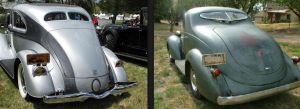- Home
- About Us
- Join/Renew
- Member Benefits
- Member Pages
- Log In
- Help
- Museum Store
Home Page › Forums › General › What would the never produced 1934 Studebaker-based P-A’s have looked like?
I’m really enjoying your artistic efforts. I happen to have a 1937
Studebaker State President. My understanding is that the body is the
same as the Dictator Six( 116″ wheelbase) and that the 125″ wheelbase
of the President “8” is made up in the length of the hood. The body
is designed by Raymond Loewy, and the interior was designed by Miss
Helen Dryden as the “weaker” sex had a large say in car purchasing. The
Dictator Six won first place in California’s National Gas Economy
Classic by averaging 24.27 MPG. The President “8” was also first in its
class, averaging 20.34 MPG. The planar independent front suspension
was equipped with modern type shock absorbers and it was the first year
windshield defrosters were offered by Studebaker. Studebaker introduced
rotary door latches for safety, an industry wide first in ’37. Now if
you can figure a way to upgrade my President to a 1701 P-A (they both
came stock with overdrive), it would be appreciated.
Tony,
You are a Marvel!
Merry Christmas,
Peter
Paul –
You might enjoy taking a look at the early 1933 issues of Autobody magazine. In the March or April issue is a story about streamline design featuring drawings of Pierce-Arrow’s 1934 sedan body – but does not mention Pierce-Arrow’s name.
Brooks
A 155″ wheelbase car would be an absolute beast.
Most modern parking lots would be quite inadequate for a vehicle that size.
Paul, great illustrations of an interesting topic.
Paul, you’ve sure created a modern, streamlined design…for 1934!
Compared to, say, a square, box-like 1934 Packard, your Pierce-Arrow adaptation wins the styling comparison hands down!
And, along those same styling lines, it’s too bad that Pierce’s 1933 Silver Arrow advertising tag line, “Suddenly, it’s 1940” didn’t encourage more buyers into the showroom.
Glad you are all enjoying these explorations!
Tony,
Your ’37 Studebaker President is one of my favorite cars of that period regardless of price, very advanced styling and with all the wonderful features you mentioned. Halfway into this period video on Studebaker’s 1934 all-steel bodies is a cliff-falling demo of yet another attribute – battleship strength – which carried into your series.
Yes, your car has 9 inches added forward of firewall, with shared Dictator bodies aft rather than 4 inch longer bodies like ‘34-35. The common roof was most likely chosen because it was, I believe, a single stamped piece, which required an expensive die and press.
Checked engine gaskets online to guestimate block length of Studebaker’s Six and 250 and 337 Eights, and P-A’s Eight. Scaling images based on known bore diameters, appeared to be about 24 inches for the Six, upwards of 30 inches for the 250 Eight and around 33-34 inches for the 337 and Pierce Eight. In 1934-5, Studebaker added 6 inches to hood (aka front axle-to-dash) to go from Six to 250 Eight. From 1938-42 they added 5-1/2 inches. This squares with the lengths guestimated. But in ’36-37 a full 9 inches was added. Why?
My hypothesis is that in 1934 when the ’36 was being designed, Studebaker was still holding out the possibility of re-introducing its 337 Eight. Looking at several pictures of ’36-37 Studebaker engine bays it appears that there is a 3-4 inch space between the engine block and fan that is not there in the shorter wheelbase Six or in 250 Eights prior or subsequent to that series. There is also a bracket projecting out from the block to span the distance, which am not sure supports the belt or serves some other purpose.
If the hypothesis is correct, you may well be able to fit a 337 Eight or even a big Pierce Eight under hood. Wouldn’t THAT be something!
Have been exploring Pierce-Arrow design possibilities based on the ’36-37 Studebaker, will share soon. Is admittedly like projecting the path of a hurricane but we know much more than we may realize.
Brooks,
Are those magazines available in the Detroit area such as at Gratiot library? Will run down there next week if they are open.
If they depict the actual ’34 models that Pierce offered, indicates that the March, 1933 bankruptcy may have been known internally some time in advance and that Pierce designers were directed to begin creating a new series divorced from Studebaker far sooner than the April-May, 1933 timeframe.
Because of the incredible sea change in styling that took place in early 1933, particularly due to the Cadillac Sixteen Aero Coupe and Silver Arrow, together with Pierce’s late redirect of its ’34 product strategy, one good thing that resulted was that the company had a chance to quickly bring new, advanced streamlining elements to production. The surfacing on the ’34-35 Pierces is exquisite, with nary a straight edge to be found. Studebaker-based Pierces would not have seen such surfacing until 1936.
Paul –
The NAHC has a set of Autobody; they are fascinating. I forget of Motor Vehicle Monthly was published that late, but they are worth checking if there.
Not a great deal is known about the streamlined Pierce-Arrows after the Silver Arrow was made; that design was modified by Studebaker. The 1935 bankruptcy records include a list of rejected parts; among them are the body panels for the 836A listing Murray Corporation as the creditor. There was some PAS discussion recently about Wilson Body Company bodying some Series 80 models, something that might also be covered in Autobody). Wilson was one of the original components of Murray; Murray went on to do some bodies for Lincoln. The eccentric rear quarter window in the 1933 Autobody story drawing reminds that Murray’s chief design Amos Northup drew like that. So, I would not be surprised if Stude contracted out Pierce’s 1934 bodies, as Lincoln was doing, and Northup drew them.
I gave a copy of the Pierce bankruptcy list to the Society years ago, together with the 1937 red herring prospectus for the Pierce-Arrow Motor Corporation, so you should find them with other Pierce materials at Hershey. The Society had some Ewing Galloway photographs of the 1934 cars – very sharp images, showing different models coming down the end of the production line – they should be over there, too. The Arrow published them decades ago; the little Pierce-Arrow book from the New Zealand author has them, too. Studying the Brunn limousine, a sedan and an 836A that may give you more ideas.
I hope this helps
Brooks
Thanks Brooks and btw, thoroughly enjoyed R-F-PA vs C-C-L-P, while “No Mistaking” is on the list.
Wonder if there is a way to find out which model names Pierce trademarked for 1934 and 1935, and when. Quick rummage through the U.S. Patent and Trademark website indicates a sink hole so will need to find a more productive approach. Want to know, for example, if 833 and 1233 were secured.
Will start discussion of 1936-7 Studebaker-based possibilities with the President Eight sedan on 125 inch wheelbase. It shares its body with the 116 inch Dictator Six, the last 9 inches devoted to longer hood and front fenders and the recently retired 337 Eight likely package-protected. Two roofs were tooled, this sedan version and a rumble seat coupe with unique split backlight. The series was well executed, every bit the equal to mighty GM that year.
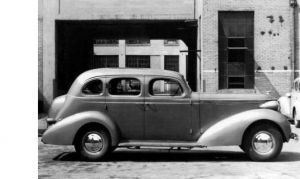
Besides the extra long hood, the only clues I have seen regarding hints at what a more upscale variant would have looked like is this image, found here:
http://www.studebakerqld.org.au/category/library/articles/page/4
The story suggests a British origin. Perhaps our Studebaker owners know more.

Scaling the previous image leads me to conclude that it rests on an approximately 137 inch wheelbase, with 5 inch longer front doors borrowed from the rumble seat coupe and 7 inch longer rear doors. The additional 12 inches would likely have been the minimum needed to fit flip-down auxiliary seats behind the front seat, in addition to the division window shown in the image.
Here is what the car would have looked like using the first image as basis. I should note that the first image is the 1937 President, which had a unique grill and hood design. Compare to previous image’s front grill from 1936.
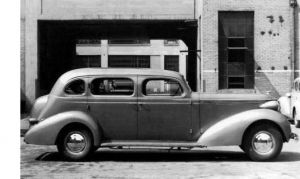
Paul –
I am not sure how much Studebaker was doing for Pierce-Arrow, so you may have to look for more than one or two possible identities. I suggest going into the Patent and Trademark office in person for a comprehensive search – the office is now located outside the city – and they can help find what you need.
I forget who was making/designing Studebaker’s bodies at this time – but is it still before Helen Dryden?
Brooks
Now its time to investigate the Pierce-Arrows. First is the easy one, the 125 wb President with Pierce grill and headlamps. Hood and fender lengths are pretty much aligned with the 1601-3 series and with no “style” space ahead of the big Eight like the 1934-35 Studebaker-based cars, which would have had 6-7 inches. The industry was changing, engines and cabins moving forward and rear overhangs increasing, for handling, ride comfort, luggage space and when executed deftly, style.
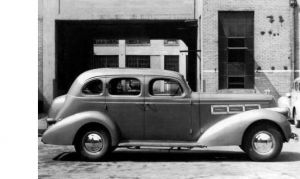
Next two are straightforward. First is Club Sedan per 1936 1601 proportioning and luggage capacity. Moves rear wheels back 9 inches, resulting in 136 inch wheelbase. Roof and doors reused from President. Important to note that overall height would be several inches lower than 1601.
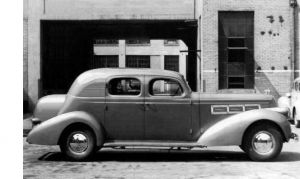
Second is 6-window version, again per 1601. Discovered that President’s rear roof rake had to be stiffened a whopping 21 degrees to mimic 1601.
These are the cars that P-A might have made if still Studebaker-based although the 6-window version would have now been problematic because it would have required either a newly tooled and very expensive roof, which P-A likely would not have been able to afford, or a cut & insert of existing roof. Either way the cost to customer would have been higher than in previous years. This would have been the appropriate time for P-A to settle on one roof for its 2-row vehicles, and the Studebaker version would have been perfect. Gone would have been the affordable touring car with rear spread room to spare.
Looking at the two cars, I think there was opportunity for something differently proportioned. Before exploring, will show a few other styles per P-A and Studebaker thinking of the day.
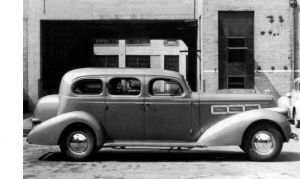
Good suggestion, Brooks.
Next up is 131 wb car based on company’s mindset that went into 1934 836A. In recent article about P-A’s final years (The Arrow, Series 16 Model 1) there is discussion about the new leadership soliciting input from several sources including outside design firms. I believe the input supported the 836A specifically, the rest of the line’s design likely frozen and ready for tooling by August, 1933. The new ideas appear to have included one or more of the following:
– less costly grill, more steeply raked and of modern appearance
– clean hood with no vents (added later… was cooling an issue?)
– 4 window greenhouse with rear doors pulled back over rear fenders and curved
– rear quarters and decklid fully integrated with and a natural extension of the body, and with increased rear overhang. Had been common on 2-door sedans and 2/4 coupes but generally not on 4 door styles. In retrospect this was excellent input because it represented the future for the 4 door sedan and a tremendous opportunity for Pierce-Arrow, of more later.
Car uses Studebaker’s roof, which would have been the name of the game going forward. Pierce would have needed to tool very selectively to gain maximum benefit for minimum cost.
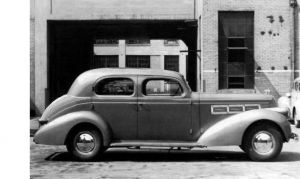
Aero time.
Definitely on the minds of Studebaker and Pierce-Arrow in these years, it’s cruel irony that neither pioneer enjoyed the success of later copycats.
My attempts aren’t that good, more illustrative of general mindset. Studebaker initially seemed to prefer a fairly continuous roof sweep except for slight widow’s peak, four side windows rather than six, and four little windows enabling rear visibility. Image sits on 133 wb sans running boards. Rear skirts complete the look.
1934-5 Land Cruiser was less successful than likely hoped, and expensive one piece roofs drove decision making for 1936.
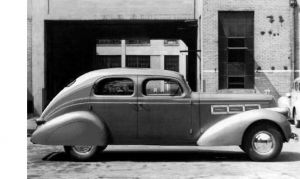
Variation using P-A’s production Silver Arrow’s solution to rear visibility, again not well executed on my part. Kept the running boards.

Each company developed interesting aero window shapes in the rear, both of which would have been in play were such a car to have been pursued for 1936. The Studebaker shown is ’36 2/4 coupe.
